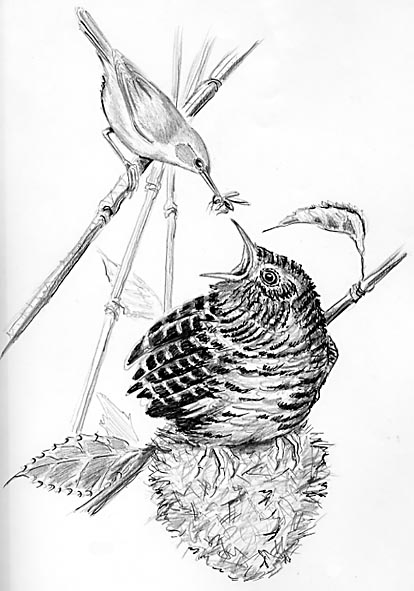
Dear Bird Folks,
Perhaps you can enlighten me about cuckoos and their egg laying behavior. They can see into the future like no soothsayer ever could. It seems impossible to lay similar eggs into a nest the eggs of which the bird has never seen.
– Hannah, Harwich.
What, Hannah?
Your note has been sitting on my desk for the past two months. I would have answered you sooner, but I have no idea what you are talking about. “Cuckoos”? “Soothsayer”? “Eggs never seen before”? Huh? Anybody else have any ideas? I feel bad because you also wrote – off the record – some real nice things about our columns. But I honestly don’t know what you are looking for. I’ve asked other people for help, tried holding your note up to a mirror, and even ran it through my secret decoder ring, but couldn’t crack your question. So, I’ve decided to write about Common (European) Cuckoos, on the off chance that’s what you are looking for. If I’m wrong, I apologize. But, if I’m correct, I’m going quit my night job and become a soothsayer. Although, that won’t such a big deal since I don’t even have a night job.
I’d be willing to bet that most people out there have no idea what a Common Cuckoo looks like. But, I would also be willing to bet that everyone has heard one before. The Common Cuckoo does the voice-over for all those millions of cuckoo clocks around the world; hence, the name. Every time one of those mechanical birds pops out of a clock and says “cuckoo, cuckoo,” the Common Cuckoo gets a royalty. The real cuckoos have made so much money from all those clocks that they no longer need to raise their own kids. They have some other bird do it for them. Really. Now that’s one smart bird.
Okay, maybe the cuckoos don’t actually pay other birds to raise their kids; it’s really a lot more sinister than that. Here’s how they do it. The female cuckoo sits and watches other birds (aka, host birds) build their nests and lay their eggs. The moment one of the host birds leaves, to either find some food or pick up the mail, the cuckoo makes her move. She flies in and carefully picks up one of the host bird’s eggs up with her bill. Now, while still holding the egg, she straddles the nest, hovering just above it, like a germ freak using a public toilet. She then quickly lays one of her eggs and is gone in a flash, still carrying the stolen egg. The entire process probably takes about ten seconds, just like human childbirth does. Right?
The baby bird, growing inside the cuckoo’s egg, is much more developed than the host’s eggs are, and thus hatches sooner. Now, here’s the part where it gets creepy. The newly hatched, totally blind, naked baby cuckoo instinctively pushes against anything it touches. When it touches an egg of the host bird, it pushes and pushes until the little cuckoo pushes the other egg clean out of the nest. In a fairly short time the still blind baby cuckoo pushes every single one of the host’s eggs out of the nest. Man, I thought my kids were pushy.
Once the host’s eggs are out of the way, the hosts are free to spend their entire day feeding and caring for the young cuckoo, which may grow to four times the size of the foster parents. Host birds are often only the size of a titmouse, while the cuckoo is larger than, say, a Common Grackle. It’s both weird and comical to see the little birds feeding the giant baby cuckoo. It must be where they got the idea for those Baby Huey cartoons.
Here, in good old North America, we have those whacky cowbirds that also lay eggs in the nests of other birds. But the cowbird eggs may not match the eggs of the host bird and sometimes the host spots the intruder’s egg and gives it the old heave-ho. Cuckoos are a bit trickier than cowbirds. Cuckoos look for host birds whose eggs match their own. But here comes the interesting part. Not all cuckoos lay eggs with the same coloring. Cuckoo “A” has different looking eggs than cuckoo “B.” So cuckoo “A” will often ignore a nest of eggs that doesn’t match its own, but that same nest may be a good match for cuckoo “B.” It is thought that the cuckoos don’t really know about egg color, but may instead simply be laying their eggs in the nests of birds that look like the birds that raised them. If a particular host bird was good enough for them, it’s good enough for their kids.
I hope this somehow answers your question, Hannah. I also hope you noticed that I didn’t make any cheap “cuckoo” jokes. Ever since I’ve become a respected author I’ve decided to raise my standards. From now on it’s nothing but sophisticated quips from me. You know, like jokes about childbirth and Baby Huey.